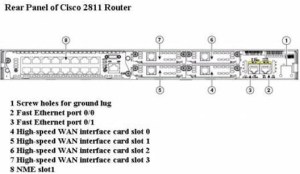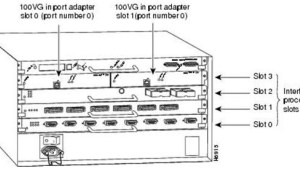Cisco Device Port Naming Convention
Instructor, Andrew Stibbards
One of the questions I get from students almost every week is, “Why is my first FastEthernet interface called FastEthernet 0/0, and not just FastEthernet 0?” Let’s break this down…
The first thing you need to remember is the convention: slot#/port#. With this convention it is indicating from less to more specific which port you are referencing. The slot can be the device itself or a slot for HWICs (High-Speed WAN Interface Card) or NMEs (Enhanced Network Module). By default non-modular devices, or switches and routers that have no extra slots for HWICs or NMEs, have only one slot, slot 0. So all interfaces will be in slot 0, such as FastEthernet 0/0 or FastEthernet 0/24. Devices that have expansion slots also have slot 0, that is their built in ports. When you start plugging in modules, they become slots 1,2,3….and so on. So with slot you are indicating where the port is, either on the device, or on a card on the device. Then comes the port number. So if I tell you to go configure port GigabitEthernet 0/23 on a switch, you know that it is a built in port, and it is the twenty-third one in. Here is an example of a 2811 router, with its built in ports and slots.

Now, when you start adding in slots, it does get a little interesting. What you have to remember for the naming is right to left / bottom to top. For example when you look at a 2811 router, it has 4 HWIC interfaces. If you were to plug a module into each one, when the router booted up it would discover all 4. The bottom-right HWIC would be slot 0, the bottom-left would be slot 1, the top-right would be slot 2, and the top-left would be slot 3. So let’s suppose we plug an HWIC into slot 0 with two FastEthernet interfaces. Now we run into a problem, because we can’t just use FastEthernet 0/0 to reference the first port. That would reference the port built into the router itself.
So when you are referencing the slots, the convention changes. Now it is: slot#/subslot#/port#. So to get to that first interface we would say FastEthernet 0/0/0, because it is in slot 0 (on the router), subslot 0 (first subslot), port 0 (first interface on the slot). You might also say FastEthernet 0/3/1. Same router, fourth HWIC, second port. If you only have one device, the slot number will always be 0. If you were to have multiple devices in a chassis setup, the slot number will now reference which of the devices you’re modifying. You might see a port FastEthernet 3/3/0. That would be slot 3 (for the third device), subslot 3 (third module on the device), port 0 (first interface on the slot). So the convention expands to account for more complex setups, but it is still referencing least specific down to most specific. Here is an example of a Cisco 7505 setup with multiple slots.

You can see here the device will recognize multiple slots and their ports. If you wanted to configure the 100VG port in the top right, you would use the command #interface vg 3/1/0 to access it. Slot 3, subslot 1, and port 0.
The easy way to figure out what interfaces your device recognizes will be to use the #show ip interface brief command. This will list all interfaces in the order recognized by the device. At boot time as part of the POST (power on self test) is the interface discovery process. As it powers on the device checks all built-in as well as HWIC and NME slots for installed modules. If it finds one, it powers the module and adds the interfaces to the available configuration. Usually the order will be the built-in interfaces and then the modules in the order of the display.
In conclusion, the naming convention is there to help you identify exactly which interface you are configuring, and where it is physically located. Which slot and port, or which chassis slot, subslot, and port. Just keep in mind less to more specific, and right-to-left, bottom-to-top.
For more information regarding Authorized Cisco Training classes at LRS Education Services, please contact me at the email address below!
Margaret
Margaret.Teague@LRS.com